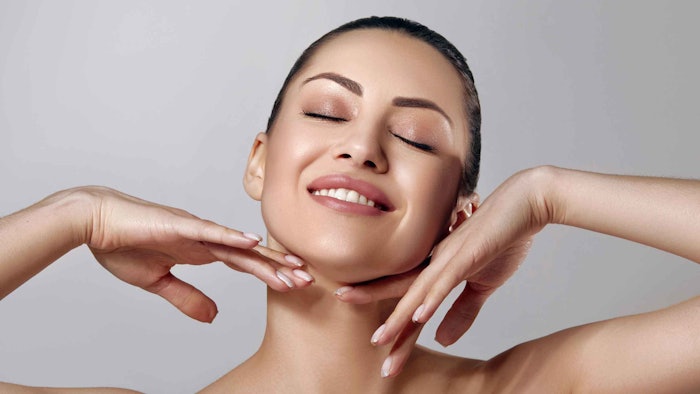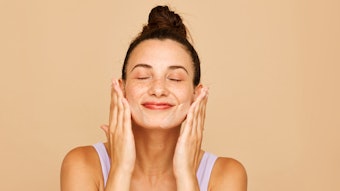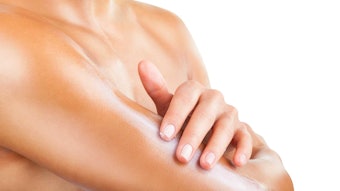
Over-cleansing, over-exfoliating or harsh cleansing can pose a risk to the skin and its microflora, disrupting the balance while also causing discomfort, redness, dehydration, etc. As a result, brands are seeking gentle, soothing solutions for skin.1 Furthermore, the buzz around the importance of a healthy skin microbiota has driven consumers toward microbiome-friendly related claims – on top of their continued growing demand for natural cosmetics.
Log in to view the full article
Over-cleansing, over-exfoliating or harsh cleansing can pose a risk to the skin and its microflora, disrupting the balance while also causing discomfort, redness, dehydration, etc. As a result, brands are seeking gentle, soothing solutions for skin.1 Furthermore, the buzz around the importance of a healthy skin microbiota has driven consumers toward microbiome-friendly related claims – on top of their continued growing demand for natural cosmetics.
Responding to these concerns and demands, a purified and hyperbranched dextrina was developed and evaluated as described here for potential skin soothing and protective benefits. In addition, the absence of adverse effects by the ingredient on the qualitative and quantitative repartition of representative microorganisms was tested by a third party. Results suggest the ingredient presents a natural, soothing and microbiome-friendly solution for skin.
Hyperbranched Dextrins
A large variety of components can be found under the common INCI designation of dextrin. The patented dextrin explored herea was derived from corn starch using dextrinization and purification processes to obtain a specific molecular weight fraction of 100% natural origin that is free of reducing sugars and rich in D-glucose units with a high number of non-typical 1:2 and 1:3 bonds.
Apart from its specific physical and organoleptic properties in aqueous solutions, this hyperbranched dextrin can form a layer at the surface of the stratum corneum to provide a soft and silky after-feel. It was recently described for its soothing properties and behavior toward healthy skin microbiota;2 additional in vitro and in vivo tests for these characteristics were carried out as described next to quantify the impact of the dextrin on inflammatory marker expression and associated clinical signs after chemically and mechanically induced inflammation.
In vitro Inflammation and Soothing Tests
IL-1α expression in keratinocytes: A first in vitro study was performed in a keratinocyte monolayer (n = 12) to quantify the expression of the pro-inflammatory marker IL-1α by ELISA. The protocol comprised a 6-hr pre-treatment with sodium lauryl sulfate (SLS) at a subtoxic concentration (0.5% v/v), followed by 20-hr applications of aqueous solutions of 2% or 5% hyperbranched dextrin (see Formula 1).
 Formula 1. Dextrin Solutions for Keratinocyte Studies
Formula 1. Dextrin Solutions for Keratinocyte Studies
Results, including comparisons versus established benchmarks, demonstrated both a strong reduction of IL-1α and an efficient soothing effect (see Figure 1). Such effects are accompanied by a quick decrease in redness and transepidermal water loss, as previously shown.3 The results demonstrated treatments with dextrin at 2% and 5% led to significant reductions in IL-1α.
 Figure 1. IL-1α expression after 26-hr treatment (6 hr SLS + 20 hr formulas A and B)Roquette Beauté
Figure 1. IL-1α expression after 26-hr treatment (6 hr SLS + 20 hr formulas A and B)Roquette Beauté
Protecting cell integrity in 3D RHE: In vitro studies also were carried out on a 3D reconstructed human epidermis (RHE) model to evaluate the ingredient’s ability to protect cell integrity. Here, inflammation was again induced by the application of SLS at 0.5% for 6 hr followed by a 20-hr application of either the previously described formulation B (5% dextrin); synthetic alpha bisabolol at 0.5% (w/v); or a dermo-pharmaceutical cream containing 0.05% (w/v) betamethasone (synthetic corticoid). Comparisons were made with an untreated control; i.e., no SLS pretreatment and no formulation or cream/product application.
RHE cell integrity was quantified after treatment by measuring lactate dehydrogenase (LDH) via enzymatic colorimetric assay to confirm cell viability was maintained. LDH is a membrane protein released upon disruption; a higher LDH activity therefore indicates lower cell viability.4, 5 Figure 2 demonstrates percentage of membrane integrity retained after the 26-hr treatment protocol as indicated by the colorimetric measurements of LDH release.
 Figure 2. Percentage of membrane integrity indicated by colorimetric measure of LDH releaseRoquette Beauté
Figure 2. Percentage of membrane integrity indicated by colorimetric measure of LDH releaseRoquette Beauté
Formula B and betamethasone cream each induced statistically similar effects on the release of LDH, per ANOVA analysis followed by Tukey multiple comparison (p < 0.05); i.e., both maintained membrane integrity. Only the formula containing 0.5% bisabolol significantly decreased membrane integrity, which could potentially indicate an adverse inflammatory effect, rather than a soothing effect.
IL-1α expression in 3D RHE: A second in vitro study on 3D RHE, carried out under the same treatment conditions as the cell integrity measurements, focused on the expression IL-1α after the application of the same formulation B or betamethasone cream, in comparison with the untreated control. Results in Figure 3 show formula B significantly reduced (by 26%) the expression of the pro-inflammatory marker IL-1α, indicating strong soothing properties. These effects were as efficient as the betamethasone cream.
 Figure 3. Soothing effects as indicated by IL-1α reductionRoquette Beauté
Figure 3. Soothing effects as indicated by IL-1α reductionRoquette Beauté
Study 1 In vivo: Soothing Effects Post-chemical Aggression
Two blind clinical studies in more than 100 volunteers explored the soothing benefits of the dextrin ingredient after chemical and mechanical aggression. Study 1 focused on chemical aggression and included instrumental measurements of the effects of three products (see Formula 2). For this purpose, each formulation was applied twice daily for seven days by homogeneous groups of 20 male volunteers with sensitive skin (declarative).
 Formula 2. In vivo Test Prototypes
Formula 2. In vivo Test Prototypes
To generate the inflammation consecutive to a chemical aggression, patches containing a solution of 10% SLS were applied to the inner sides of the forearms on Day 0, where they remained for 20 hr before being removed 4 hr prior the D1 measurement. Post-aggression soothing properties were then evaluated in three ways: by TEWLb, to reflect skin barrier function efficacy; chromameterc, to measure parameter a* related to skin redness; and the self-scoring of discomfort parameters including redness, heat or tightening sensations, to assess immediate soothing effects.
TEWL measurements: As noted, TEWL measurements were taken on the inner side of the forearm at different times: Day 0, before SLS patch application; Day 1, after SLS patch removal; Day 1 + 30 min after test product application; and days 2, 3, 4 and 7. The results shown in Figure 4 reveal that formula D containing 5% w/w dextrin protected the skin against TEWL right after application. It also significantly reduced TEWL vs. the placebo after seven days, and helped to maintain an efficient skin barrier function to retain skin hydration.
 Figure 4. Change in TEWL after chemical aggressionRoquette Beauté
Figure 4. Change in TEWL after chemical aggressionRoquette Beauté
Skin redness: Regarding skin redness, parameter a* (of the L*a*b* colorimetric system) was measured on the inner side of the forearm at: Day 0, before SLS patch application; Day 1, after SLS patch removal; Day 1 + 5 min after test product application; Day 1 + 10 min after test product application; Day 1 + 30 min after tested product application; and days 2, 3, 4 and 7.
The evolution of redness was examined by comparison to D1 (after SLS patch removal) and treated vs. untreated. Results shown in Figure 5 established both immediate and long-lasting calming properties for formula D that significantly reduced redness vs. α-bisabolol after 10 min, 30 min and seven days vs. the placebo.
 Figure 5. Measure of skin redness after chemical aggressionRoquette Beauté
Figure 5. Measure of skin redness after chemical aggressionRoquette Beauté
Self-scoring: Finally, as noted, volunteers rated discomfort they felt, such as skin redness, heat or tightening sensations, after chemical aggression and test treatment application. Formula D, containing 5% of the dextrin ingredient, efficiently reduced these sensitive skin concerns as soon as 10 min after chemical aggression (not shown).
Study 2 In vivo: Soothing Effects Post-mechanical Aggression
The second clinical study examined the potential soothing effects of formulas C and D, described previously, after the mechanical aggression of shaving. For this purpose, two homogeneous groups of 20 volunteers with sensitive skin shaved their beards daily for 28 days and applied either formula C or D in a double-blind manner. Soothing properties were evaluated by two criteria: TEWL and volunteer responses.
TEWL measurements: First, measurements of TEWLb were performed: on Day 0, after beard shaving; Day 0 + 10 min after test product application; Day 14 after beard shaving; Day 14 + 10 min after test product application; Day 28 after beard shaving; and Day 28 + 10 min after test product application.
The results shown in Figure 6 again indicate that formula D protected the skin against TEWL right after application. This may be attributed to the previously mentioned layer that dextrin can form on the skin, in addition to its observed effects against IL-1α. Formula D also significantly reduced TEWL vs. the formula C placebo after 28 days.
 Figure 6. Change in TEWL after mechanical aggressionRoquette Beauté
Figure 6. Change in TEWL after mechanical aggressionRoquette Beauté
Verbatim responses: Volunteers’ spontaneous verbatim responses to a satisfaction inquiry also were recorded at the end of the study (Day 28). These confirmed the soothing properties conferred by the dextrin-containing formula; examples included the following.
- “Less and less redness after each shave.”
- “Soothes and reduces redness.”
- “Protects and soothes the skin.”
- “It fulfills its aftershave function well by covering up any irritations.”
- “Like a second protective skin, a pleasant filter that protects, hydrates and strengthens the epidermis.”
Microbiome-friendly Assessments
As explained in the introduction, there is growing interest in cosmetics that do not alter skin microbiota since microbiome diversity has been deemed essential to skin health.6-10 Numerous pathologies such as skin sensitivity and acne relate to changes in the balance of skin microbiota diversity or quantity.11
Adding to the complexity, the human skin microbiome varies from person to person depending on sex, age, external conditions, etc.12 Each body site also harbors a characteristic composition of bacteria, viruses and fungi.
Specialized companies and services have emerged that evaluate and certify the influence (or absence of influence) of cosmetic products and personal care ingredients on key microbial players. One entityd, for example, examines the influence of a product on the natural, healthy skin balance; bacterial diversity; and growth behavior of microbes of specific body regions.13 Here, the global results are evaluated with grades from 1 to 3, awarding respectively two different categories: scores of 1.0 - 2.0 = “microbiome friendly” and scores of 2.1 - 3.0 = “microbiome damaging.”
Formula B (with 5% dextrin) was tested according to these standards to cover multiple cosmetic applications, including: rinse-off and leave on, for face, lips, body neck, chest, hands, back, thighs and scalp – and adapted to the intimate category/vaginal tract. All scores fell between 1.1 and 1.3, indicating the ingredient would be microbiome friendly for all the applications tested.
This absence of effects on the microbiome is directly linked to the ingredient’s unique composition of hyperbranched saccharides, being free of reducing sugars and rich in non-common glucose-to-glucose linkages. These characteristics do not constitute a fermentation substrate, thus it is not easily metabolized by the bacteria and fungi naturally present on skin. It therefore does not stimulate the growth of certain microorganisms at the expense of others, and in turn does not alter the healthy skin microbiota balance.
Moreover, unlike strongly alkaline, anionic or cationic ingredients and biocides, this dextrin does not contain molecules or chemical groups that can harm skin microflora. Therefore, it preserves the diversity of the skin's microbiota and its unique natural ecosystem.
Conclusion
As consumers focus on health and wellness, soothing and protecting skin and supporting and protecting the microbiome are important elements. The described hyperbranched dextrin can impart these appealing benefits – and furthermore, meet consumer demand for natural solutions.
a Beauté by Roquette DE 006 (INCI: Dextrin), Roquette; FR2022905
b Tewameter TM300TM, Courage & Khazaka
c Spectrocolorimeter CM2600D TM, Minolta
d MyMicrobiome
References
1. Chan, K. (2023, May). Patent insights: Drive intimate care innovation. Mintel. Available (with purchase) at https://store.mintel.com/report/patent-insights-drive-intimate-care-innovation#accordion-subheading-1-product-toc
2. Wils, D. (2022). How can carbohydrate molecules offer a wide range of benefits to the skin? LinkedIn. Available at https://tinyurl.com/35bek6y5
3. Di Paolo, N.C. and Shayakhmetov, D.M. (2016, Jul 19). Interleukin 1α and the inflammatory process. Nature Immunology. Available at https://www.nature.com/articles/ni.3503
4. van Ruissen, F., Le, M., Carroll, J.M., van der Valk, P.G.M and Schalkwijk, J. (1998, Apr). Differential effects of detergents on keratinocyte gene expression. Journal of Investigative Dermatology. Available at https://www.sciencedirect.com/science/article/pii/S0022202X15400478
5. G-Biosciences. (2016, Mar 31). The Protein Man’s blog. A discussion of protein research. Why is LDH (lactate dehydrogenase) release a measure for cytotoxicity? Available at https://info.gbiosciences.com/blog/why-is-lactate-dehydrogenase-ldh-release-a-good-measure-for-cytotoxicity
6. Mintel. (Accessed 2023, Sep 29). Mintel GNPD Jul-2021-Jun 2023. Available (with login) at portal.mintel.com.
7. KuRunData/Mintel (2022, May/Jun and Dec). Overall, by skin type. Available (with login) at portal.mintel.com.
8. Datastory: Xiaohongshu. (Accessed 2023, Sep 29). Apr 2023-Jun 2023. Available (with service) at https://celerdata.com/blog/xiaohongshu-delivers-integrated-advertising-analytics-with-starrocks
9. Kantar Profiles. (Accessed 2023, Sep 29). January 2022, Nov 2021 and Dec 2020. Available (with service) at https://tinyurl.com/4pvu9akz
10. Dynata/Mintel. (Accessed 2023, Sep 29). June 2022. Available (with service) at https://www.dynata.com/
11. Chen, Y.E., Fischbach, M.A. and Belkaid, Y. (2018, Jan 25). Skin microbiota-host interactions. Nature. Available at https://doi.org/10.1038/nature25177
12. Skowron, K., Bauza-Kaszewska, J., … Gospodarek-Komkowska, E., et al. (2021). Human skin microbiome: Impact of intrinsic and extrinsic factors on skin microbiota. Microorganisms. Available at https://doi.org/10.3390/microorganisms9030543
13. MyMicrobiome. (Accessed 2023, Sep 27). An overview of our standards. Available at https://microbiome-friendly.com/en/cosmetic-standards










